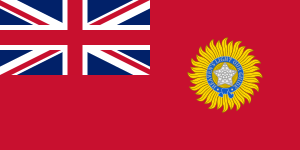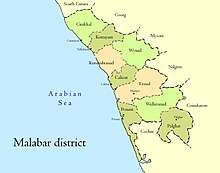Malabar District
Malabar District was an administrative district of Madras Presidency[2] in British India and independent India's Madras State. The British district included the present-day districts of Kannur, Kozhikode, Wayanad, Malappuram, Palakkad (excluding some areas of Alathur and Chittur Taluks), and Chavakad Taluk of Thrissur district (former part of Ponnani Taluk) in the northern and central parts of Kerala state, the Lakshadweep Islands, and the Gudalur taluk of Nilgiris district in Tamil Nadu. The district lay between the Arabian Sea on the west, South Canara District on the north, the Western Ghats to the east, and the princely state of Cochin to the south. The district covered an area of 15,009 square kilometres (5,795 sq mi), and extended 233 km (145 mi) along the coast and 40–120 kilometers (25–75 miles) inland. The name Mala-bar means the "hillside slopes". Kozhikode was the capital of Malabar. It was divided into North Malabar and South Malabar in 1793 for administrative convenience.
| Malabar District മലബാര് ജില്ല | |
|---|---|
| District of Madras Presidency | |
| 1792–1957 | |
 Flag | |
 Malabar district and taluks | |
| Capital | Calicut |
| Area | |
• 1941 | 15,009 km2 (5,795 sq mi) |
| Population | |
• 1941 | 3,929,425[1] |
| History | |
• Territories ceded by Tipu Sultan | 1792 |
| 1957 | |
History
Most of Malabar District was included among the territories ceded to the British East India Company in 1792 by Tipu Sultan of Mysore at the conclusion of the Third Anglo-Mysore War; Wayanad was ceded in 1799 at the conclusion of the Fourth Anglo-Mysore War. The region was organized into a district of Madras Presidency. The administrative headquarters were at Calicut (Kozhikode). After Indian independence, Madras Presidency was reorganized into Madras state, which was divided along linguistic lines on 1 November 1956, when Malabar District was merged with erstwhile Kasaragod Taluk immediately to the north and the state of Travancore-Cochin to the south to form the state of Kerala. Malabar District was divided into the three districts of Kozhikode, Palakkad, and Kannur on 1 January 1957. The Chavakkad region of the Ponnani Taluk was transferred to the Thrissur district. Malappuram District was created from parts of Kozhikode and Palakkad in 1969, and Wayanad District was created in 1980 from parts of Kozhikode and Kannur.
Until the arrival of British, the term Malabar was used as a general name for Kerala. From the time of Cosmas Indicopleustes (6th century CE) itself, the Arab sailors used to call Kerala as Male. Al-Biruni (AD 973 - 1048) must have been the first writer to call this country Malabar. The Arab writers had called this place Malibar, Manibar, Mulibar, and Munibar. Malabar is reminiscent of the word Malanad which means the land of hills. According to William Logan, the word Malabar comes from a combination of the Malayalam word Mala (hill) and the Persian/Arabic word Barr, (country/continent). [3] Mala in Malayalam means "hill". Varam means "slope" or "side of a hill". In Northern and North-Central Kerala (including all Malabar districts except Palakkad, Thrissur and parts of Malappuram district), where Malabar proper is located, words that start in Southern Malayalam/Tamil with the letter "V" tend to be pronounced with the letter "B". Thus, some of the historians argue that the word Malabar comes from the Northern Malayalam words Mala-Bar(am) meaning "hillside land".
Geography
The district was widely scattered and consists of the following parts:-
- Malabar Proper extending north to south along the coast, a distance of around 240 kilometers, and lying between N. Lat 10° 15′ and 12° 18′ N and E.Long. 75° 14′ and 76° 56′.
- A group of nineteen isolated bits of territory lying scattered, fifteen of them in the native state of Cochin and the remaining four in those of Travancore, but all of them near the coastline. These isolated bits of territory form the taluk of British Cochin.
- Two other detached bits of land, the Tangasseri and the Anchuthengu, within the Travancore.
- Four inhabited and ten uninhabited islands of Lakshadweep. The four inhabited islands are: Agatti, Kavaratti, Androth, and Kalpeni.
- The solitary island of Minicoy.
Demography
| Year | Pop. | ±% p.a. |
|---|---|---|
| 1871 | 2,261,250 | — |
| 1881 | 2,365,035 | +0.45% |
| 1891 | 2,652,565 | +1.15% |
| 1901 | 2,800,555 | +0.54% |
| 1911 | 3,015,119 | +0.74% |
| 1921 | 3,098,871 | +0.27% |
| 1931 | Not available | — |
| 1941 | 3,929,425 | — |
| Source:[1] | ||
Taluks
- Calicut (Area:980 square kilometres (379 sq mi); Headquarters:Calicut)
- Chirakkal (Area:1,750 square kilometres (677 sq mi); Headquarters:Chirakkal), now Kannur
- Cochin (Area:5.2 square kilometres (2 sq mi); Headquarters:Cochin)
- Ernad (Area:2,540 square kilometres (979 sq mi); Headquarters:Manjeri)
- Kottayam (Area:1,270 square kilometres (489 sq mi); Headquarters:Kottayam), now Thalassery
- Kurumbranad (Area:1,310 square kilometres (505 sq mi); Headquarters:),now Vatakara
- Laccadive Islands (Headquarters:Kavaratti)
- Palghat (Area:1,670 square kilometres (643 sq mi); Headquarters:Palghat)
- Ponnani (Area:1,100 square kilometres (426 sq mi); Headquarters:Ponnani)
- Valluvanad (Area:2,280 square kilometres (882 sq mi); Headquarters:), now Perinthalmanna
- Wynad (Area:2,130 square kilometres (821 sq mi); Headquarters:Kalpetta)
Modern day Taluks and Islands in erstwhile Malabar
Kannur District
Wayanad District
- Mananthavady
- Sulthan Bathery
- Vythiri (Kalpetta)
Kozhikode District
Nilgiris District
Malappuram District
- Tirurangadi
- Eranad (Manjeri)
- Nilambur
- Perinthalmanna
- Kondotty
- Tirur
- Ponnani
Palakkad District
Thrissur District
Lakshadweep District
Representatives from Malabar to Madras State
- In C. Rajagopalachari Ministry: 1) Kongattil Raman Menon (1937–39), 2) C. J. Varkey, Chunkath (1939)
- In Prakasam Ministry: 1) R. Raghavamenon (1946–47)
- In Ramaswami Reddyar Ministry: 1) Kozhippurathu Madhavamenon (1947–49)
- In P. S. Kumaraswami Ministry: 1) Kozhippurathu Madhavamenon (1949–52)
- In C. Rajagopalachari Ministry: 1) K. P. Kuttikrishnan Nair (1952–54) Kalladi Unnikammu Sahib
Cuisine
The Malabar cuisine depicts it culture and heritage. It is famous for Malabar biriyani. The city is also famous for Haluva called as Sweet Meat by Europeans due to the texture of the sweet. Kozhikode has a main road in the town named Mittai Theruvu (Sweet Meat Street, or S.M. Street for short). It derived this name from the numerous haluva stores which used to dot the street.
Another speciality is banana chips, which are made crisp and wafer-thin. Other popular dishes include seafood preparations (prawns, mussels, mackerel) . Vegetarian fare includes the sadya.
However, the newer generation is more inclined towards to Chinese and American food. Chinese food is very popular among the locals.
See also
References
- Official Administration of the Madras Presidency, Pg 327
- Chisholm, Hugh, ed. (1911). . Encyclopædia Britannica. 17 (11th ed.). Cambridge University Press. p. 452.
- Sreedhara Menon, A. Kerala Charitram (2007 ed.). Kottayam: DC Books. p. 27. ISBN 9788126415885. Retrieved 19 July 2020.
- Malabar Manual in Two Volumes by William Logan, first published in 1887, reprinted by Asian Educational Services in 1951.